2017-09-21 - Nº 125
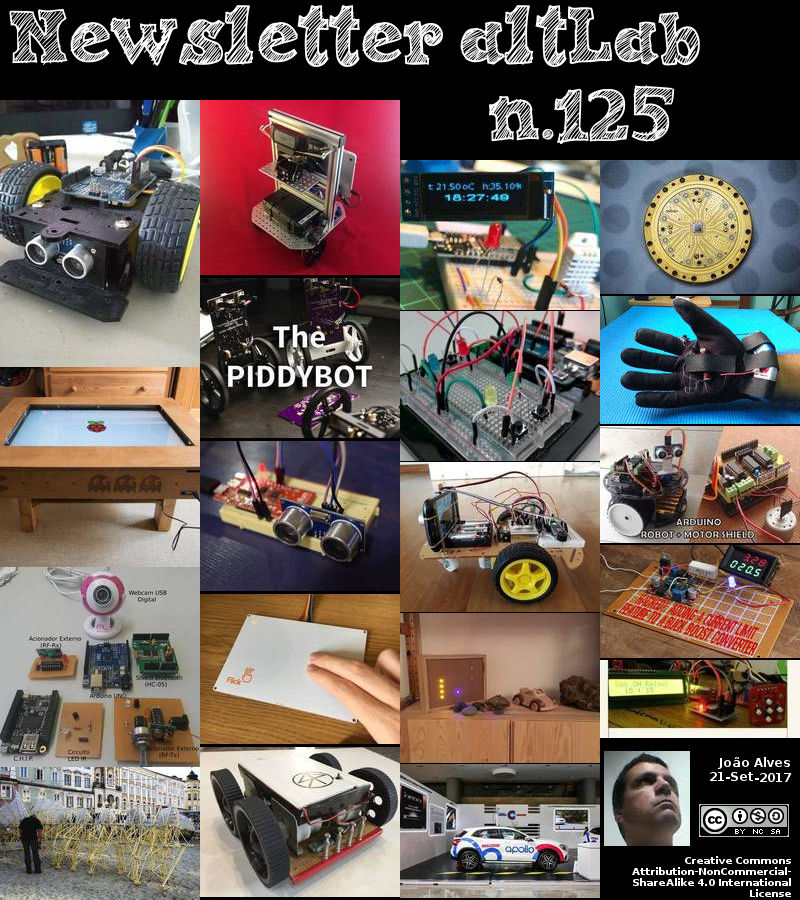
Editorial
Esta é a Newsletter Nº 125 que se apresenta com o mesmo formato que as anteriores. Se gostar da Newsletter partilhe-a!
Todas as Newsletters encontram-se indexadas no link.
Esta Newsletter tem os seguintes tópicos:
....
Faz hoje anos que nascia, em 1756, John Loudon McAdam. Este engenheiro escocês foi responsável pela invenção do processo de construção de estradas designado por "Macadam". Pedras eram colocadas em três níveis, com as pedras mais pequenas esmagadas colocadas por cima. Isto proporcionava uma viagem mais rápida e segura. Mais tarde, ele adicionou asfalto para fixar a camada superior. Faz também anos hoje que nascia, em 1832, Louis Paul Cailletet. Este físico francês destacou-se pelo seu trabalho sobre a liquefação de gases. Trabalhando no negócio de metalurgia do seu pai, ele investigou a permeabilidade do ferro ao hidrogénio e outros gases, considerando o comportamento imprevisível de alguns ferros em termos de excesso de gases dissolvidos.
Faz igualmente anos hoje que nascia, em 1853, Heike Kamerlingh Onnes. Este físico holandês ficou conhecido pelo seu trabalho sobre física de baixa temperatura onde ele liquidificou o hidrogénio e o hélio. Dos seus estudos sobre a resistência dos metais a baixas temperaturas, ele descobriu a supercondutividade (um estado em que certos metais apresentam quase nenhuma resistência eléctrica a uma temperatura próxima do zero absoluto).
Faz também anos que nascia, em 1866, H. G. Wells. Este escritor inglês ficou conhecido na história por ter escrito as obras "A maquina do tempo" (1895), "A ilha do dr. Moreau" (1896), "O homem invisível" (1897), "A guerra dos mundos" (1898), entre outras. Por este motivo foi apelidado de "pai da ficção cientifica" conjuntamente com Jules Verne.
Por fim faz anos hoje que nascia, em 1926, Donald A. Glaser. Este físico e neuro-biologista norte-americano, ficou conhecido pela sua invenção da câmara de bolhas usada na física de partículas subatómicas. Nesta era possível constatar que o comportamento de partículas subatómicas pode ser observado pelos trilhos que eles deixam. Uma fotografia instantânea regista o caminho da partícula. A câmara de Glaser contém um líquido super-aquecido mantido em estado super-aquecido e instável sem ferver. Um pistão que causa uma diminuição rápida da pressão cria uma tendência a ferver ao menor distúrbio no líquido. Então, qualquer partícula atómica que passa pela câmara deixa um trilho de pequenas bolhas de gás causadas por uma fervura instantânea ao longo do seu caminho onde os iões que ela cria servem como centros de desenvolvimento de bolhas.
Na semana que passou foi finalmente anunciado pela Oracle o Java SE 9 (JDK 9), Java Platform Enterprise Edition 8 (Java EE 8) e Java EE 8 Software Development Kit (SDK). O JDK 9 é uma implementação pronta para produção da Java SE 9 Platform Specification, que foi aprovada recentemente junto com o Java EE 8 no Java Community Process (JCP). O Java SE 9 fornece mais de 150 novos recursos, incluindo um novo sistema de módulos e melhorias que trazem mais escalabilidade, segurança melhorada, melhor gestão de desempenho e desenvolvimento mais fácil para a plataforma de programação mais popular do mundo. O Java EE 8 moderniza e simplifica a plataforma Java EE para a cloud e microservices com actualizações para oito especificações principais. Também esta semana, a Baidu anunciou o Apollo 1.5 e um financiamento de 0 mil milhões de yuan para desenvolvimento da tecnologia de condução autónoma. O Apollo 1.5 é a última versão da plataforma autónoma de código aberto Apollo da empresa e já reúne 70 fortes parceiros. Com base no Apollo 1.0, o Apollo 1.5 abre cinco recursos principais adicionais que incluem percepção de obstáculos, planeamento, simulação em cloud, mapas de alta definição (HD) e deep learning end-to-end, fornecendo soluções mais abrangentes para desenvolvedores e parceiros de ecossistemas para acelerar a implantação da condução autónoma.
Na Newsletter desta semana apresentamos diversos projetos de maker assim como alguns modelos 3D que poderão ser úteis. É apresentada a revista Hispabrick Nº28 assim como os livros "Supporting Python 3", "Spring Framework Reference Documentation", "Internet of Things in five days", "Java Platform, Enterprise Edition - The Java EE Tutorial Release 7", "OpenCL Programming Guide for the CUDA Architecture" e "Linux Fundamentals".
 João Alves ([email protected])
João Alves ([email protected])
O conteúdo da Newsletter encontra-se sob a licença  Creative Commons Attribution-NonCommercial-ShareAlike 4.0 International License.
Creative Commons Attribution-NonCommercial-ShareAlike 4.0 International License.
Novidades da Semana

Oracle Announces Java SE 9 and Java EE 8
_"Oracle today announced the general availability of Java SE 9 (JDK 9), Java Platform Enterprise Edition 8 (Java EE 8) and the Java EE 8 Software Development Kit (SDK). JDK 9 is a production-ready implementation of the Java SE 9 Platform Specification, which was recently approved together with Java EE 8 in the Java Community Process (JCP). Java SE 9 provides more than 150 new features, including a new module system and improvements that bring more scalability, improved security, better performance management and easier development to the world’s most popular programming platform. Java EE 8 modernizes and simplifies the Java EE platform for the cloud and microservices with updates to eight major specifications. Java SE 9 The defining feature of Java SE 9 is the Java Platform Module System, also known as Project Jigsaw, which makes it easier for developers to reliably assemble and maintain sophisticated applications. The module system also makes the JDK itself more flexible, allowing developers to bundle just those parts of the JDK that are needed to run an application when deploying to the cloud. [...]
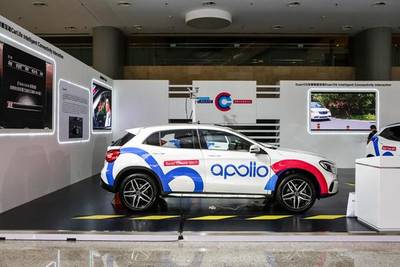
Baidu Announces Apollo 1.5 and a 10 Billion yuan Autonomous Driving Fund
_"Baidu, Inc. (NASDAQ:BIDU), announced on Wednesday the release of Apollo 1.5, the latest iteration of the company’s Apollo open-source autonomous driving platform that has gathered 70 strong partners so far. The company also announced a 10 billion RMB ($1.5 billion) Apollo Fund to invest in 100 autonomous driving projects in the next three years. Building on Apollo 1.0, Apollo 1.5 opens up five additional core capabilities which include obstacle perception, planning, cloud simulation, High-Definition (HD) maps and End-to-End deep learning, providing more comprehensive solutions to developers and ecosystem partners to accelerate the deployment of autonomous driving. The obstacle perception capability enables vehicles to accurately identify obstacles during both day and night. With the planning capability, vehicles can plan the correct driving path and make optimal driving decisions. The cloud simulation system on Apollo is the only platform that provides open, built-in HD maps tailored for autonomous driving. [...]
Outras Notícias

mbed OS 5.5.7 released
"We are pleased to announce the mbed OS 5.5.7 release is now available. This release includes an update for mbed-coap to version 4.0.10, bootloader support for DISCO_L476VG and a critical workaround for 'STM32F439xI-family AES hardware acceleration occasionally produces incorrect output (#4928)' (achieved by disabling AES acceleration by default). There are also numerous bug fixes and code enhancements. " [...]

Toshiba Pushes Quantum Key Distribution Speed Beyond 10Mbps
_"Toshiba Corporation (TOKYO: 6502) and Toshiba Research Europe Limited’s Cambridge Research Laboratory in the UK have brought the enhanced security of quantum cryptography closer to practical realization with development of the world’s fastest quantum key distribution device. The device has achieved a key data distribution speed of 13.7 megabits per second *1. The speed is about seven times the previous fastest quantum key distribution speed: the 1.9Mbps that Toshiba achieved in 2016. The details of the new device will be announced at the QCrypt 2017 conference, which will be held at the University of Cambridge from September 18-22. In quantum cryptography, bits are carried and transmitted on individual photons, which cannot be read-out without leaving errors as evidence of the intrusion. Thanks to this property it is possible to test and guarantee the secrecy of quantum keys. [...]

YuMi taking the stage
_"Like in previous performances held under the fresco-covered ceiling of the beautifully elegant Teatro Verdi, in Pisa, Italy, musicians sit attentive, instruments at the ready, eyes focused on the Maestro. Soloists stand ready as well, waiting for the conductor’s upward motion with the baton to begin. Yet this is no ordinary performance, and no ordinary conductor. Here, ABB’s YuMi, the world’s first truly collaborative dual-arm robot, is making its conducting debut. That was the scene last night, as YuMi directed Italian tenor Andrea Bocelli in a program of Verdi at a charity concert for the gala of the First International Festival of Robotics. Over 800 illustrious guests from around the world enjoyed the program titled “A breath of hope: from the Stradivarius to the robot.” Among the guests of this special performance was ABB CEO Ulrich Spiesshofer under whose leadership YuMi was developed when he was responsible for the turn-around of the Robotics business. [...]
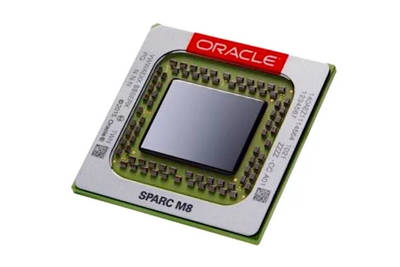
Oracle’s New SPARC Systems Deliver 2-7x Better Performance, Security Capabilities, and Efficiency than Intel-based Systems
_"Oracle today announced its eighth generation SPARC platform, delivering new levels of security capabilities, performance, and availability for critical customer workloads. Powered by the new SPARC M8 microprocessor, new Oracle systems and IaaS deliver a modern enterprise platform, including proven Software in Silicon with new v2 advancements, enabling customers to cost-effectively deploy their most critical business applications and scale-out application environments with extreme performance both on-premises and in Oracle Cloud. SPARC M8 processor-based systems, including the Oracle SuperCluster M8 engineered systems and SPARC T8 and M8 servers, are designed to seamlessly integrate with existing infrastructures and include fully integrated virtualization and management for private cloud. All existing commercial and custom applications will run on SPARC M8 systems unchanged with new levels of performance, security capabilities, and availability. The SPARC M8 processor with Software in Silicon v2 extends the industry’s first Silicon Secured Memory, which provides always-on hardware-based memory protection for advanced intrusion protection and end-to-end encryption and Data Analytics Accelerators (DAX) with open API’s for breakthrough performance and efficiency running Database analytics and Java streams processing. Oracle Cloud SPARC Dedicated Compute service will also be updated with the SPARC M8 processor. [...]
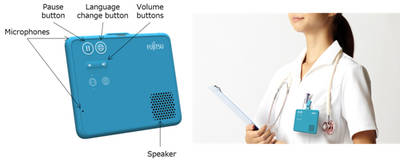
Fujitsu Develops World's First Wearable, Hands-Free Speech Translation Device
_"No need to physically manipulate the device to communicate while care giving in hospital wards and a variety of other situations Fujitsu Laboratories Ltd. today announced the development of the world's first wearable, hands-free speech translation device, suitable for tasks in which the users' hands are often occupied, such as in diagnoses or treatment in healthcare. In recent years, with an increase in the number of visitors to Japan, more and more non-Japanese patients are going to hospitals, creating issues in supporting communication in multiple languages. In 2016, Fujitsu Laboratories developed hands-free technology that recognizes people's voices and the locations of speakers, and that automatically changes to the appropriate language without physical manipulation of the device. That same year, it also worked with the University of Tokyo Hospital and the National Institute of Information and Communications Technology (NICT) to conduct a field trial of multilingual speech translation in the medical field using stationary-type tablets. Based on the results, Fujitsu Laboratories learned that, as there are many situations in which healthcare providers have their hands full, such as when providing care in a hospital ward, there was a great need for a wearable speech translation device that could be used without being physically touched. In order to expand the usability of multilingual speech translation, Fujitsu Laboratories has developed the world's first compact, wearable, hands-free speech translation device by developing technology to differentiate speakers using small omnidirectional microphones. [...]

Enable CAN Flexible Data Rate (CAN FD) in New and Existing Designs using Microchip’s Unique External CAN FD Controller
_"The industry’s first external CAN Flexible Data Rate (CAN FD) controller is now available from Microchip Technology Inc. (NASDAQ: MCHP). The MCP2517FD allows designers a simplified path to upgrade from CAN 2.0 to CAN FD and benefit from CAN FD protocol enhancements CAN FD offers many benefits over traditional CAN 2.0 including faster data rates and data byte message expansion. The cutting-edge MCP2517FD CAN FD controller can be used with any microcontroller (MCU), enabling developers to easily implement this technology without a complete system redesign. Since the adoption and transition to CAN FD is in the beginning stages, there are a limited number of CAN FD MCUs available today. In addition, changing a system MCU can come with a significant cost, increased development time and risk. MCP2517FD allows system designers to enable CAN FD functionality by adding only one external component while continuing to utilize the majority of their design. [...]
Ciência e Tecnologia
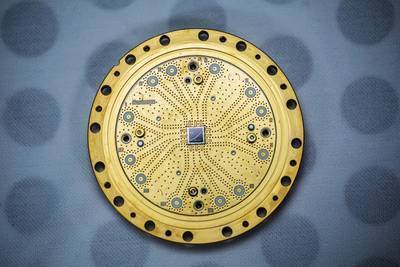
First quantum computers need smart software
_"The world is about to have its first quantum computers. The complexity and power of quantum hardware, such as ion traps and superconducting qubits, are scaling up. Investment is flooding in: from governments, through the billion-dollar European Quantum Technology Flagship Program, for example; from companies, including Google, IBM, Intel and Microsoft; and from venture-capital firms, which have funded start-ups. One such is ours, Rigetti Computing, which in June opened the first dedicated facility for making quantum integrated circuits: Fab-1 in Fremont, California. The vision is that commercial quantum- computing services will one day solve problems that used to be unimaginably hard, in areas from molecular design and machine learning to cybersecurity and logistics.1 The problem is how best to program these devices. The stakes are high — get this wrong and we will have experiments that nobody can use instead of technology that can change the world. [...]
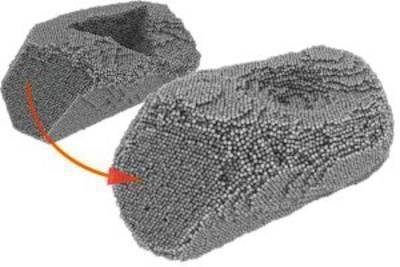
Self-healing Gold Particles
_"Materials with a Shape Memory so far Have Had to Be Composed of Various Components in a Painstaking Process – Scientists now Discovered Self-healing Powers of Pure Gold Self-healing materials are able to repair autonomously defects, such as scratches, cracks or dents, and resume their original shape. For this purpose, they must be composed of several components whose combined properties result in the desired characteristics. Scientists of the Karlsruhe Institute of Technology (KIT) and the Technion – Israel Institute of Technology now discovered that also tiny particles of pure gold have surprising self-healing capacities. Lending shape memory to materials is a very complex, painstaking effort. In pure metals, self-healing capacities repairing mechanically caused defects so far have been considered impossible. However, they have now been observed by scientists in pure gold. [...]
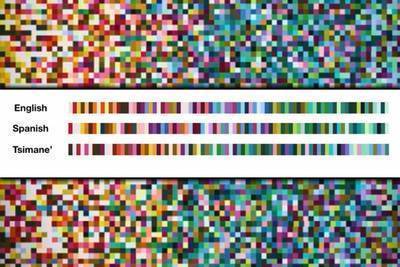
Analyzing the language of color
_"The human eye can perceive millions of different colors, but the number of categories human languages use to group those colors is much smaller. Some languages use as few as three color categories (words corresponding to black, white, and red), while the languages of industrialized cultures use up to 10 or 12 categories. In a new study, MIT cognitive scientists have found that languages tend to divide the “warm” part of the color spectrum into more color words, such as orange, yellow, and red, compared to the “cooler” regions, which include blue and green. This pattern, which they found across more than 100 languages, may reflect the fact that most objects that stand out in a scene are warm-colored, while cooler colors such as green and blue tend to be found in backgrounds, the researchers say. This leads to more consistent labeling of warmer colors by different speakers of the same language, the researchers found. “When we look at it, it turns out it’s the same across every language that we studied. [...]
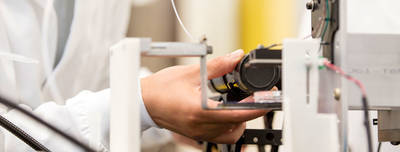
Engineer Developing Methods, Applications To Construct Blood Vessels Using 3-D Printing Technology
_"Changxue Xu's research is critical to the development of 3-D organ printing. Changxue Xu lab The survival of any living tissue, whether it’s small in size or forms a complex network like a vital organ, depends on the delivery of vital nutrients and oxygen to survive. The thicker the tissue, and it could be by only a few hundred microns, the more vital a vascular structure becomes. Researches are hard at work around the world trying to develop viable, transplantable replacement organs using 3-dimensional printing as a way to solve the shortage of donor organs, whether it’s lungs, heart, kidneys or any other organ that can fail. But in order for 3-D organs to function properly, they have to have a strong vascular network that can deliver the vital nutrients necessary for their survival. That is what Changxue Xu has been focused on for the last several years. [...]
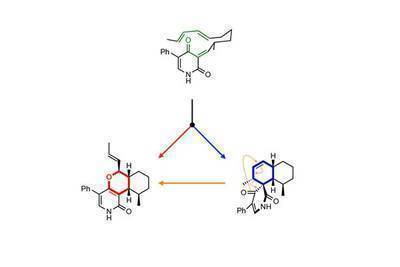
UCLA, Japanese scientists discover new way to speed up chemical reactions
_"A team of scientists and engineers from UCLA and Japan’s University of Shizuoka has discovered a new mode of enzyme catalysis, the process that speeds up chemical reactions. The researchers also demonstrated that the enzyme, called LepI, can catalyze reactions that were not previously observed in nature. Through computational modeling, they found that the process happens in a unique way that can create two different molecules at once. “Mother Nature has amazing powers as a chemist in using enzymes to construct complex molecules in very efficient ways,” said Yi Tang, a UCLA professor of chemical and biomolecular engineering and a principal investigator on the study. “Our discovery showcased one naturally occurring enzyme and how it can be used as a tool to catalyze a very important and heavily studied synthetic reaction. This also suggests there could many more such enzymes waiting to be discovered and engineered.” The study was published in the journal Nature. [...]
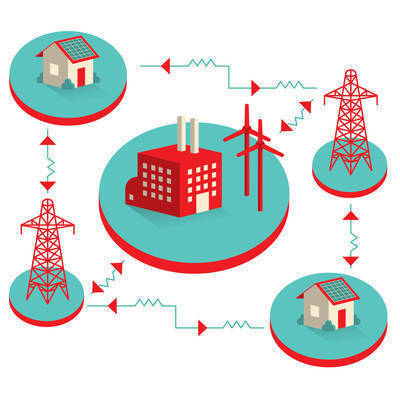
SLAC-Led Project Will Use Artificial Intelligence to Prevent or Minimize Electric Grid Failures
_"A project led by the Department of Energy’s SLAC National Accelerator Laboratory will combine artificial intelligence with massive amounts of data and industry experience from a dozen U.S. partners to identify places where the electric grid is vulnerable to disruption, reinforce those spots in advance and recover faster when failures do occur. The eventual goal is an autonomous grid that seamlessly absorbs routine power fluctuations from clean energy sources like solar and wind and quickly responds to disruptive events – from major storms to eclipse-induced dips in solar power – with minimal intervention from humans. “This project will be the first of its kind to use artificial intelligence and machine learning to improve the resilience of the grid,” said Sila Kiliccote, director of SLAC’s Grid Integration, Systems and Mobility lab, GISMo, and principal investigator for the project. “While the approach will be tested on a large scale in California, Vermont and the Midwest, we expect it to have national impact, and all the tools we develop will be made available either commercially or as open source code.” Called GRIP, for Grid Resilience and Intelligence Project, the project builds on other efforts to collect massive amounts of data and use it to fine-tune grid operations, including SLAC’s VADER project. It’s one of seven Grid Modernization Laboratory Consortium projects aimed at boosting grid resilience that will receive up to $32 million in funding as part of the DOE’s Grid Modernization Initiative. GRIP was awarded up to $6 million over three years. [...]
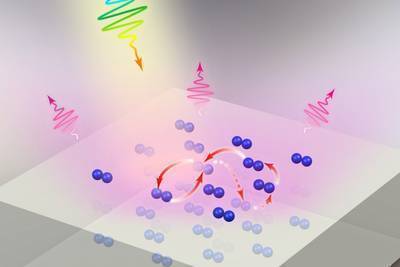
A new approach to ultrafast light pulses
_"Two-dimensional materials called molecular aggregates are very effective light emitters that work on a different principle than typical organic light-emitting diodes (OLEDs) or quantum dots. But their potential as components for new kinds of optoelectronic devices has been limited by their relatively slow response time. Now, researchers at MIT, the University of California at Berkeley, and Northeastern University have found a way to overcome that limitation, potentially opening up a variety of applications for these materials. The findings are described in the journal Proceedings of the National Academy of Sciences, in a paper by MIT associate professor of mechanical engineering Nicholas X. Fang, postdocs Qing Hu and Dafei Jin, and five others. The key to enhancing the response time of these 2-D molecular aggregates (2DMA), Fang and his team found, is to couple that material with a thin layer of a metal such as silver. The interaction between the 2DMA and the metal that is just a few nanometers away boosts the speed of the material’s light pulses more than tenfold. [...]
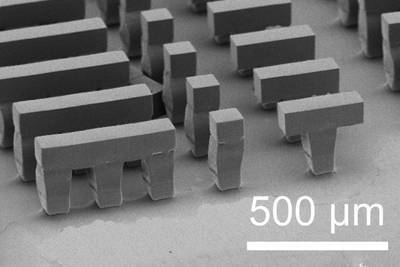
One vaccine injection could carry many doses
_"Microparticles created by new 3-D fabrication method could release drugs or vaccines long after injection. MIT engineers have invented a new 3-D fabrication method that can generate a novel type of drug-carrying particle that could allow multiple doses of a drug or vaccine to be delivered over an extended time period with just one injection. The new microparticles resemble tiny coffee cups that can be filled with a drug or vaccine and then sealed with a lid. The particles are made of a biocompatible, FDA-approved polymer that can be designed to degrade at specific times, spilling out the contents of the “cup.” “We are very excited about this work because, for the first time, we can create a library of tiny, encased vaccine particles, each programmed to release at a precise, predictable time, so that people could potentially receive a single injection that, in effect, would have multiple boosters already built into it. This could have a significant impact on patients everywhere, especially in the developing world where patient compliance is particularly poor,” says Robert Langer, the David H. Koch Institute Professor at MIT. Langer and Ana Jaklenec, a research scientist at MIT’s Koch Institute for Integrative Cancer Research, are the senior authors of the paper, which appears online in Science on Sept. 14. [...]

One Step Closer to Lifelike Robots
_"Researchers at Columbia Engineering have solved a long-standing issue in the creation of untethered soft robots whose actions and movements can help mimic natural biological systems. A group in the Creative Machines lab led by Hod Lipson, professor of mechanical engineering, has developed a 3D-printable synthetic soft muscle, a one-of-a-kind artificial active tissue with intrinsic expansion ability that does not require an external compressor or high voltage equipment as previous muscles required. The new material has a strain density (expansion per gram) that is 15 times larger than natural muscle, and can lift 1000 times its own weight. Their findings are outlined in a new study (DOI 10.1038/s41467-017-00685-3), “Soft Material for Soft Actuators,” published today by Nature Communications. Previously, no material has been capable of functioning as a soft muscle due to an inability to exhibit the desired properties of high actuation stress and high strain. Existing soft actuator technologies are typically based on pneumatic or hydraulic inflation of elastomer skins that expand when air or liquid is supplied to them. [...]
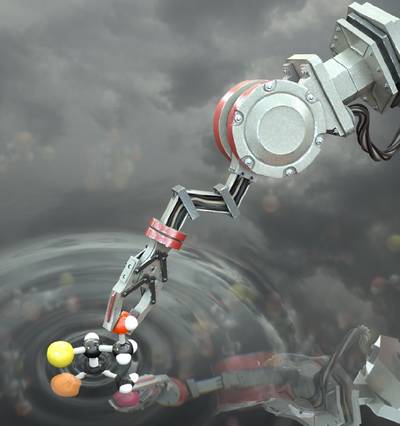
Scientists create world’s first ‘molecular robot’ capable of building molecules
_"Scientists at The University of Manchester have created the world’s first ‘molecular robot’ that is capable of performing basic tasks including building other molecules. The tiny robots, which are a millionth of a millimetre in size, can be programmed to move and build molecular cargo, using a tiny robotic arm. Each individual robot is capable of manipulating a single molecule and is made up of just 150 carbon, hydrogen, oxygen and nitrogen atoms. To put that size into context, a billion billion of these robots piled on top of each other would still only be the same size as a single grain of salt. The robots operate by carrying out chemical reactions in special solutions which can then be controlled and programmed by scientists to perform the basic tasks. In the future such robots could be used for medical purposes, advanced manufacturing processes and even building molecular factories and assembly lines. [...]
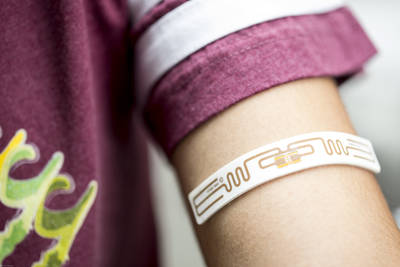
UW team shatters long-range communication barrier for devices that consume almost no power
_"University of Washington researchers have demonstrated for the first time that devices that run on almost zero power can transmit data across distances of up to 2.8 kilometers — breaking a long-held barrier and potentially enabling a vast array of interconnected devices. For example, flexible electronics — from knee patches that capture range of motion in arthritic patients to patches that use sweat to detect fatigue in athletes or soldiers — hold great promise for collecting medically relevant data. But today’s flexible electronics and other sensors that can’t employ bulky batteries and need to operate with very low power typically can’t communicate with other devices more than a few feet or meters away. This limits their practical use in applications ranging from medical monitoring and home sensing to smart cities and precision agriculture. By contrast, the UW’s long-range backscatter system, which uses reflected radio signals to transmit data at extremely low power and low cost, achieved reliable coverage throughout 4800-square-foot house, an office area covering 41 rooms and a one-acre vegetable farm. The system is detailed in a paper to be presented Sept. 13 at UbiComp 2017. [...]

Automatic code reuse
_"Researchers at MIT’s Computer Science and Artificial Intelligence Laboratory (CSAIL) have developed a new system that allows programmers to transplant code from one program into another. The programmer can select the code from one program and an insertion point in a second program, and the system will automatically make modifications necessary — such as changing variable names — to integrate the code into its new context. Crucially, the system is able to translate between “data representations” used by the donor and recipient programs. An image-processing program, for instance, needs to be able to handle files in a range of formats, such as jpeg, tiff, or png. But internally, it will represent all such images using a single standardized scheme. Different programs, however, may use different internal schemes. [...]

The power of recycling could fuel vehicles in the future
_"The idea of recycling waste cooking oil into biodiesel fuel is nothing new. For years, researchers have studied the process and companies have recycled when possible. However, for many groups, cost is often the determining factor for making the effort to recycle. The U.S. alone produces 11 billion liters – 2.9 billion gallons – of waste cooking oil a year. The costs of collecting and shipping a volume of that scale are daunting. And you still have to factor in the process to recycle that oil into a usable biofuel. [...]
Modelos 3D
Com a disponibilidade de ferramentas que permitem dar azo a nossa imaginação na criação de peças 3D e espaços como o thingiverse para as publicar, esta rubrica apresenta alguns modelos selecionados que poderão ser úteis.
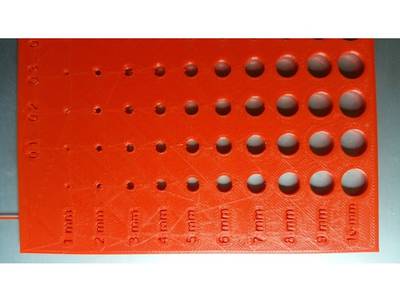
Holes Gauge 1mm-10mm
_"This is a print size gauge for designers. It's 1mm to 10.9mm in .1mm steps in a matrix. It's sized as designed. Want an 7mm rod to press fit. Size the rod to the hole and read it's size, 7.2. Design and print 7.2 and it will have the allowance you want. [...]

OpenSCAD User Manual/Example/Strandbeest
"This chapter describes how to animate a complex mechanism like the strandbeest using OpenSCAD. The model is not meant for 3D-Printing. The source code is just one file without the use of external libraries, tested with OpenSCAD version 2015.03. " [...]
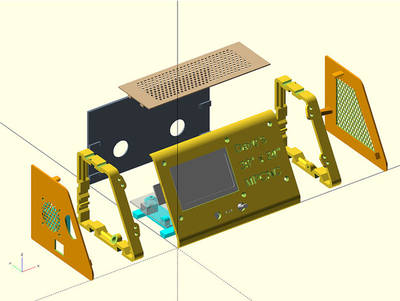
Electronics Enclosure for Arduino Mega or Rambo Mini and LCD Graphic or LCD 2004 Controller
_"This is a remix of the Combo Electronics case https://www.thingiverse.com/thing:2466915 to house the raspberry Pi and the Arduino Mega or Rambo Mini and the LCD2004 or Graphics LCD. The raspberry Pi can go on the inside or outside back plate or the Top Plate. I changed the angle of the front face plate from 60 to 75 degrees so I would not have to make the case wider. You can of course change that using the openscad source and create all new STL files. If you are putting the raspberry pi on the outside backplate or the Top plate, you will also need to print the part MonitorMountBottom_88x72Mnt_rev9.stl. This is modification to the vesa Mount plate that changed the hole pattern from the wider 100mm to 88mmx72mm to fit the back or top plate without making the case taller or wider. [...]
Documentação
A documentação é parte essencial do processo de aprendizagem e a Internet além de artigos interessantes de explorar também tem alguma documentação em formato PDF interessante de ler. Todos os links aqui apresentados são para conteúdo disponibilizado livremente pelo editor do livro.
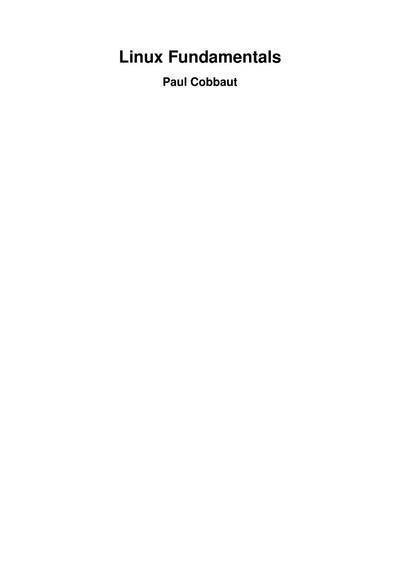
Linux Fundamentals
"This book is meant to be used in an instructor-led training. For self-study, the intent is to read this book next to a working Linux computer so you can immediately do every subject, practicing each command. This book is aimed at novice Linux system administrators (and might be interesting and useful for home users that want to know a bit more about their Linux system). However, this book is not meant as an introduction to Linux desktop applications like text editors, browsers, mail clients, multimedia or office applications. " [...]

OpenCL Programming Guide for the CUDA Architecture
"This whitepaper summarizes the guidelines for how to choose the best implementations for NVIDIA GPUs. " [...]
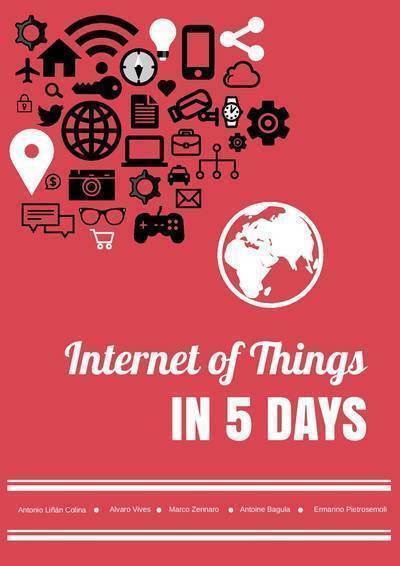
Internet of Things in five days
"The "IoT in five days" book is in active development by a joint effort from both academia and industrial collaborators, acknowledging that the Internet of Things of the future will be built on top of scalable and mature protocols, such as IPv6, 6LoWPAN and IEEE 802.15.4. Open Source Operating Systems as Contiki, with more than 10 years of history and actively supported by universities and research centers, have been paving the Internet of Things road since the early beginnings of Wireless Sensor Networks and M2M communication, enabling 24018222._UY630_SR1200,630.jpgthe new IoT paradigm. "This tutorial is a guide to developing enterprise applications for the Java Platform, Enterprise Edition 7 (Java EE 7), using GlassFish Server Open Source Edition. GlassFish Server Open Source Edition is the leading open-source and open-community platform for building and deploying next-generation applications and services. GlassFish Server Open Source Edition, developed by the GlassFish project open-source community at https://glassfish.java.net/, is the first compatible implementation of the Java EE 7 platform specification. This lightweight, flexible, and open-source application server enables organizations not only to leverage the new capabilities introduced within the Java EE 7 specification, but also to add to their existing capabilities through a faster and more streamlined development and deployment cycle. [...]

Java Platform, Enterprise Edition - The Java EE Tutorial Release 7
"This tutorial is a guide to developing enterprise applications for the Java Platform, Enterprise Edition 7 (Java EE 7), using GlassFish Server Open Source Edition. GlassFish Server Open Source Edition is the leading open-source and open-community platform for building and deploying next-generation applications and services. GlassFish Server Open Source Edition, developed by the GlassFish project open-source community at https://glassfish.java.net/, is the first compatible implementation of the Java EE 7 platform specification. This lightweight, flexible, and open-source application server enables organizations not only to leverage the new capabilities introduced within the Java EE 7 specification, but also to add to their existing capabilities through a faster and more streamlined development and deployment cycle. GlassFish Server Open Source Edition is hereafter referred to as GlassFish Server. " [...]

Spring Framework Reference Documentation
_"The Spring Framework is a lightweight solution and a potential one-stop-shop for building your enterprise-ready applications. However, Spring is modular, allowing you to use only those parts that you need, without having to bring in the rest. You can use the IoC container, with any web framework on top, but you can also use only the Hibernate integration code or the JDBC abstraction layer. The Spring Framework supports declarative transaction management, remote access to your logic through RMI or web services, and various options for persisting your data. It offers a full-featured MVC framework, and enables you to integrate AOP transparently into your software. Spring is designed to be non-intrusive, meaning that your domain logic code generally has no dependencies on the framework itself. [...]

Supporting Python 3
"This book is an open book whose source is available on GitHub[5] so that anyone can contribute to the book. The author and editor is Lennart Regebro, and future contibutors will be listed here. " [...]

HispaBrick issue 28
_"It always feels like a great achievement when we launch a new issue of HispaBrick Magazine, but I feel especially proud of this one for several reasons. I don’t want to put them in any specifi c order, and while going over them I realised they are all related to the wonderful atmosphere you can fi nd among AFOLs worldwide. I was privileged to be at the LEGO® Fan Media Days in late May and early June. It was my fi rst trip to Billund – which already made it special – and it turned out to be everything I had hoped for, and then some. Of course I came back with a ton of material from interviews, some of which you can fi nd in this issue. I also came back with ideas for many other articles. [...]
Projetos Maker
Diversos Projetos interessantes.
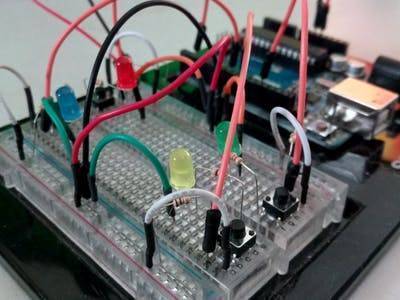
Make an Arduino Memory Game
_"A tutorial for beginners for making a memory game with an arduino and leds Do you remember the game "Simon"? A lot of people my age (born in the 70s) got to lose a lot of time playing it. The game was simple, it had 4 buttons of different colors that would light up in sequence and you had to repeat the sequence. Every time, you got it right, the game would give you the sequence again with an additional color at the end. I got one for Xmas long long ago but then I moved and moved, and moved some more so the game got lost in one of the many boxes that never get unpacked from a move to another... As an "adult", I discovered the joys of Arduino and with that, got the opportunity to revive my long lost time wasting friend. This tutorial will show you how to make a similar game using an Arduino Uno a few LEDs and resistors and a relatively simple circuit. [...]
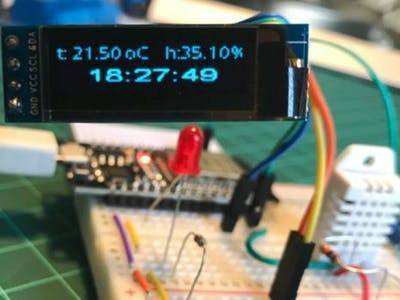
ESP32 and OLED Display: Internet Clock - DHT22
"This is the 2nd tutorial on my ESP32 learn journey. Here, an OLED shows time and captured data by DHT sensor (Temperature & Humidity) Introduction: ESP32 and OLED Display: Internet Clock - DHT22 This tutorial is a continuation of a journey to learn more about this great IoT device, the ESP32. " [...]
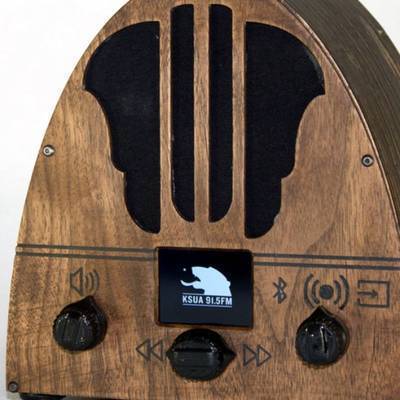
Cathedral Raspberry Pi Internet Radio
"I set out to build a RPi radio with bluetooth and aux inputs that simply switched between the stations I programmed into it. I really wanted an internet radio that I could program in radio stations I love from around the world (KSUA, WNYC, WFMU, etc). Additionally it can also be switched to bluetooth or auxiliary input modes. The whole thing was inspired by radios from the '40s and '50s. " [...]
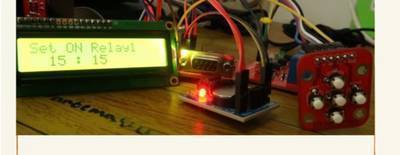
ON/OFF Timer for Smart Home
"One of the problems for an office worker is a very busy schedule, leaving early and coming home late, so they can not turn on lights or other equipment when night falls. Or it could be, they rush to go to the office, so forget to turn off other electronic equipment. Another problem, a company requires timeliness to automatically turn on or off a device. Here is one solution to reduce these problems and also reduce the risk of human error by creating a tutorial of the timer module to turn on and off electronic equipment. " [...]
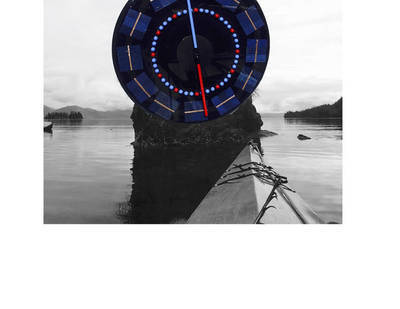
Solar Tide Clock
_"Tides. In Anchorage Alaska we live on a point located between two enormous tidal bays--so big in fact that Captain Cook on his initial survey of the area thought (hopeful thinking) that this entrance would prove to be a "northwest passage". It is shallow and all boats traversing to the port are aware of the difficulties involved with a tidal basin considered to be the second largest tide flow in the world. Strangely enough when you go through a tunnel to another port not 1/2 hour away the tidal flow is the exact opposite from the high and low tides near anchorage. Tides are dependent on the moon, sun, configuration of the ocean floor and surrounding land masses--in other words they are complicated. Old tidal clocks attempted to simplify these arrangements by reducing the periods of high and low tides to the moon movements. [...]
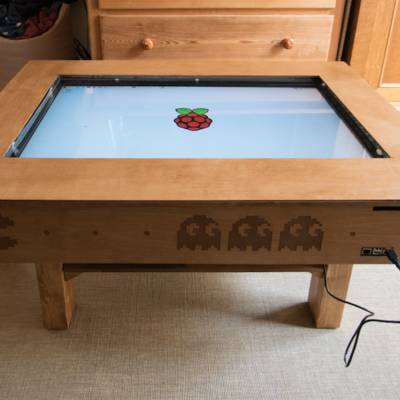
Touch Screen Coffee Table DIY With Low Cost CCD
"Build your own touch screen solution adapted on your TV by using a CCD sensor from an old scanner This tutorial is about helping people to build their own touch screen solution based on any flat screen TV. It uses light triangulation technology to read the coordinates. This method is quite cheap ( the priciest part is the TV), with a good quality image and you can make the table almost as small and as thin as your TV is.Of course, nothing is perfect and with this solution it's probably not possible to build a 100% multi-touch screen and it's hard to cover the entire screen area. But depending on the way you make it you can have some interesting results. Plus, I am sure there are a lot of possibilities I haven't thought about to improve this. ;-)" [...]

Adding a Current Limit Feature to a Buck/Boost Converter
"In this project we will have a closer look at a common buck/boost converter and create a small, additional circuit that adds a current limit feature to it. With it, the buck/boost converter can be used just like a variable lab bench power supply. Let's get started! " [...]
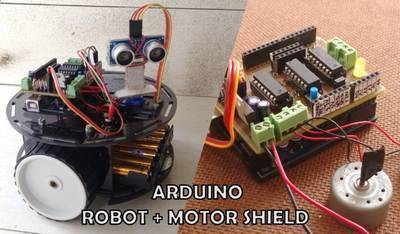
DIY Multi-Purpose Robot Base and Motor Shield
_"Hello everyone, recently I started working on some robotics related projects using Arduino. But I didn't have a proper base to work on, the end result didn't look great and only thing I could see is all my components entangled in wires. Trouble shooting any error used to take like forever and wiring things again and again was sometimes frustrating. So I decided to make a multipurpose robot along with a motor driver on which I could attach my other components easily without creating any mess and assemble and dismantle it easily for any modifications. If you are a beginner and want to get started with robotics or even when you are planning to prototype a bigger robot project first on a small scale, a prototyping base always comes in handy. This instructable covers the entire process of preparing your acrylic base, adding motors and wheels and also to make a DIY motor shield by fabricating a double sided PCB at home. [...]

Weighing Scale With Touchscreen (Arduino)
_"Ever wanted to build a Weighing Scale with a touchscreen? Never thought of it? Well read on and try building one... Do you know what a TFT touchscreen and a Load Cell are ? If Yes skip to Step 1 else just start by reading the Intro. Introduction: What is a Load Cell ? A load cell is a transducer that produces electrical signal when a force is applied on it and deforms it.There are different types of load cell: button type,canister type, beam type,S-type,etc.Here I have used the Beam Type. [...]
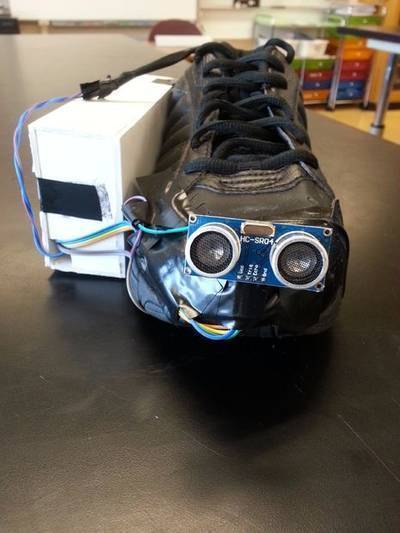
Vision Shoe (Shoe for the Blind)
"Hello, today we will be creating a shoe for the visually impaired. Such a device can make blind people blend in along with normal people and not make them stand out as when using a white cane. This can bring about significant improvement in confidence and quality of life of the visually impaired. " [...]

PIDDYBOT - DIY Arduino Balancing Robot
_"The PIDDYBOT is a small Open Source balancing robot with the aim of teaching PID controls using a "hands on" concept. Anyone can play with the PIDDYBOT and start to develop an understanding of what the P, I, and D terms within the PID loop do, even if that person has no concept of the math behind the control itself. It is a great teaching tool for the classroom. The program I have written for the PIDDYBOT uses the potentiometers to physically control the PID terms. This way you can turn them in real time and see the effect they have on the control parameters. The PIDDYBOT can also be programmed with more complex programs as well. [...]
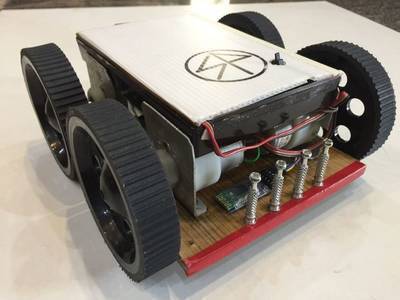
Bluetooth Controlled 4wd Car With HC-05
"Hey there! This car can be made easily by Newbies. Almost all the instructables had some or the other glitch due to which i made an easy method(also the cheapest i guess). One can easily control the car with an app via bluetooth. it is a really fun weekend project for arduino/electronic enthusiasts. " [...]
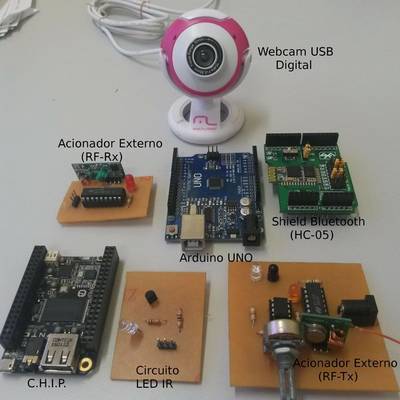
TV Remote Control based on Head Movements
"A low cost, open-source, universal-like remote control system that translates the user's head poses into commands to electronic devices. The project presents a proposal of an open-source, low cost universal remote control system that translates user’s head poses into commands to electronic devices. In addition, a proximity sensor circuit was combined to radio-frequency modules in order to act as a wireless switch. Among the applications found with respect to alternative remote controls, none of them supports head gestures as input, which would certainly make them a viable option to people whose upper limbs are compromised. " [...]
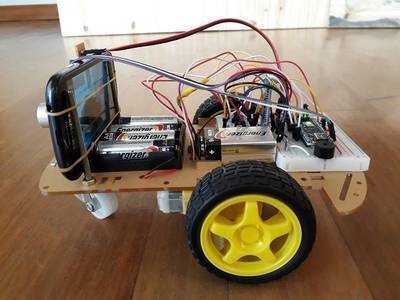
Robot Car With Bluetooth, Camera and MIT App Inventor2
"Did you ever wanted to build your own robot car? Well...this is your chance!! In this Instructable I will walk you in how to make a Robot Car controlled via Bluetooth and MIT App Inventor2. Be aware that Im a newbie and that this is my first instuctable so please be gentle in your comments. There are many instructables out there but in this one Ive tried to combine many features such as: camera streaming, obstacle avoidance, ultrasonic range sensor, Larson scanner (with charlieplexing) and battery monitoring to an Android App!! So lets get started and meet Frankie (it uses ideas from many places....hence Robo Frankenstein)" [...]
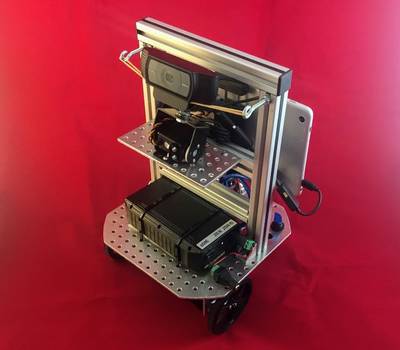
Bucket Bot 2
_"This is the latest version of the Bucket Bot - a mobile PC based robot that can be easily transported in a 5 gallon bucket. The previous one used simple wood based construction. This newer version is based on aluminum and T-Slot, so it is easily expandable. The bucket bot concept is a vertically oriented robot where all the components are easily accessible. This is superior to the layered approach since you don't need to unscrew layers to work on the lower level components. This design has the all-important features for mobile robots: a handle and motor power switch! [...]
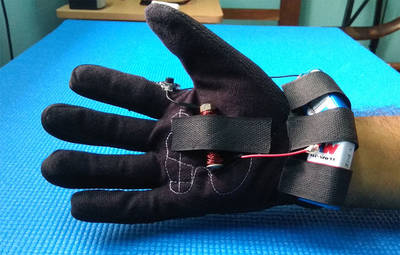
Electromagnetic Glove
_"Hi am Sundar Murugan, an Electronics hobbyists and Photographer and this is my first attempt on writing an instructable. Today am going to demonstrate making of a simple Electromagnetic Glove which I have made during the last weekend. This glove basically uses the principle of Electromagnetic induction which everyone would have read in our 7th grade science. SKILL LEVEL : Beginner (Electronics) WHAT IT WILL DO: More for fun purposes, this glove is fixed with a DIY Electromagnet which is capable of attracting things when battery is connected to it. A small button was attached to bottom side of the index finger in order to make it easy for user to press with his thumb. When this button is pressed Electromagnet placed in the glove will get magnetized and demagnetized when it is released. [...]

Arduino Bathroom Scale With 50 Kg Load Cells and HX711 Amplifier
"This Instructable describes how to make a weighing scale using readily available off the shelf parts. Materials needed: Arduino - (this design uses a standard Arduino Uno, other Arduino versions or clones should work also) HX711 on breakout board - This microchip is specially made for amplifying the signals from load cells and reporting them to another mircocontroller. The load cells plug into this board, and this board tells the Arduino what the load cells measure. 50kg load cells (x4) - Load cells are specially shaped metal parts that have strain gauges glue to them. The strain gauges are resistors that change their resitance when they are bent. When the metal part bends, the resistance of the load cell changes (the HX711 measures this small change in resistance accurately) Sturdy flat mounting surface - a stiff piece of hardwood or metal is ideal Wires in various colors for connecting all the parts Power supply for Arduino" [...]
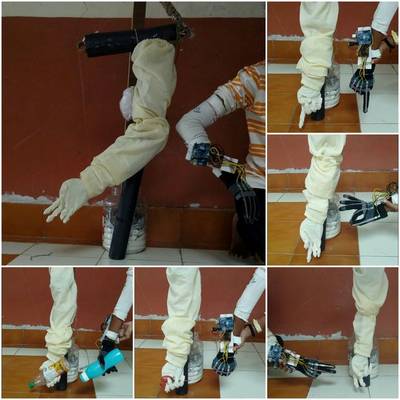
Wireless Animatronic Hand ( Gesture + Voice )
_"Basically this was our college project and we had less time to complete this project because of that we forgot to take pictures of some steps. I also designed a code using which one can control this robotic hand using gesture and voice at a same time but due to lack of time we were not able to implement it as then we had to make changes in whole circuit and I also designed a code using which you can control this project by using voice only using just Arduino board only then you will not need EasyVR shield which is costly so it is cheap method to make voice control robot . Code is attached below. The aim of this project is to design a mechanical hand and a control glove (for human hand). Mechanical hand will act as a slave by imitating the action of control glove (human hand) which will act as a master. Mechanical hand is designed using servo motors, controller and xbee module. [...]
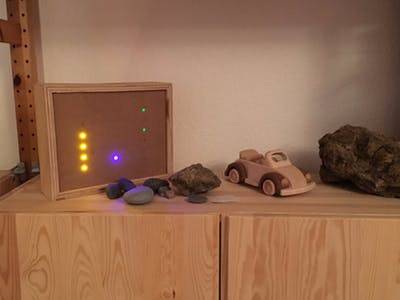
Binary Clock with Arduino and Plywood
_"A timepiece that allows to stop and think about the essence of time, and also a fun project to build! Binary Clock Prototype Building a binary clockBackgroundA couple of years ago I wanted to try out some iot-related stuff. I bought a couple of Arduino-boards and some random components and started fiddling around. At first I started out by trying some experiments such as temperature controlled LED lights and blinking stuff that reacted to sound. After this I wanted to get my feet wet and actually build something, preferably geeky, not necessarily very useful. Binary clocks have been an interest of mine for years. [...]

Make Your Own DIY 3D Gesture and Tracking USB MIDI Controller
_"With DIY gear so readily available, building your own controllers can be fun, rewarding and really creative. Here, Liam Lacey shows you how to make your own 3D gesture-sensing USB MIDI controller. Over the past ten years or so there have been a growing number of consumer products and sensors brought to market that allow 3D gesture and motion tracking for controlling computers, games consoles, and other electronic devices. These include camera-based devices such as the Microsoft Xbox Kinect or the Leap Motion Controller; accelerometer/gyroscope-based devices such as the Nintendo Wii Remote or the Apple iPhone as well as completely novel devices such as the EMG-based Thalmic Labs Myo armband or the Radar-based Project Soli sensor by Google. The majority of these devices - whether officially or through hacks - can be used to control music software; applications such as Geco MIDI for the Leap Motion Controller or Leviathan for the Myo allow these devices to be turned into expressive gesture and motion sensing MIDI/OSC controllers. There are also a few purpose-built gesture-based music controllers such as the mi.mu gloves, the Percussa Audiocubes, or the Source Audio Hot Hand. [...]

DIY a Formaldehyde Detector
_"HCOH (Formaldehyde) is colorless, poisonous, high water-soluble, high alcohol-soluble and high ether-soluble gas with an obnoxious odor. It is widely used in decoration, such as adhesives, carpeting, decorative paneling and so on. HCOH is a prominent factor in sick-building syndrome as its emissions (accelerated by heat and moisture) irritate eyes and mucous membranes in nose and throat, and cause headache and dizziness. It is widely used in decoration, such as adhesives, carpeting, decorative paneling and so on. My brotherhave just decorated a new house as the marriage house couple of days ago and he cannot wait for long, for the wedding date is fixed in 1st-Oct. There are many things to check and purify air, kinds of plants and tools. [...]
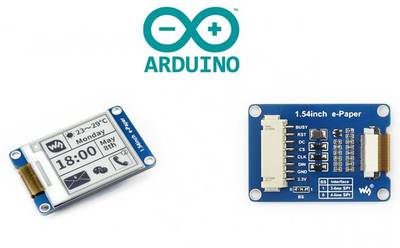
Getting Started With E-Paper Display Modules
"In this video I'm gonna show you how to load a custom image on the e-paper display. Lets see how easy it is to get started working with one of these e-paper display modules and an the Arduino environment. You can use pretty much any Arduino compatible board for this project, even an ESP8266 board will work. " [...]

Making a Moving, Wirelessly Controlled LED Display
"Introduction I have used LED matrix displays for a number of different projects over the last few years. These 8x8 LED units have a controller that allows an Arduino to talk to them sending text or graphic information that can be displayed in a number of ways. These small units can be daisy-chained together to create a long, scrolling display. " [...]
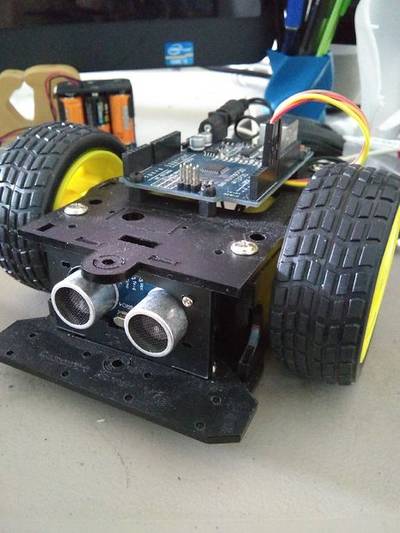
L298 DC Motor Driver Demos/Tutorial
_"In this short series - I will attempt to show different methods for using the L298 H Bridge Motor Driver Board. The L298 is commonly found in hobby and educational robots. This was put together, not to show a complete working two wheeled robot, but to attempt to explain the ideas behind the operation. It is left up to the student the method, or combination of methods they would like to use in their project (robot). IT was purposely left to not show complete code, but the code could be easy to duplicate to other pins for two motor use. The L298 can drive 2 DC Motors, these demos only use one motor, but can be duplicated on the remaining pins of the L298. [...]
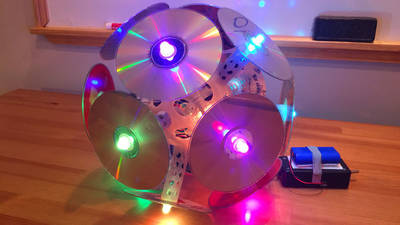
The Compact Disc-o: My LED disco ball music festival totem!
_"I made a programmable LED disco ball totem for bringing to music festivals -- a Compact Disc-o Ball, if you will. :) What's a totem? As you may know, you don't get cellular reception at many large music festivals. Also at large music festivals, you're unlikely to find your friends again if you get separated (especially at night). Thus, many people create "totems", which are basically poles with some kind of decoration on it so that you can find your friends in a crowd. The totem is a beacon for your friends -- both new and existing -- to find you and stick together. [...]
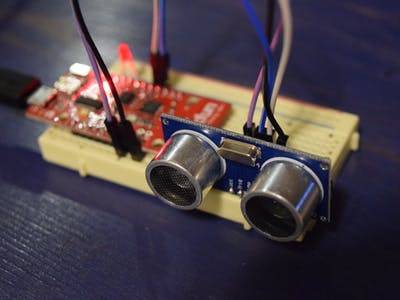
Monitor Your Front Door
"Use a Sparkfun ESP8266 Thing Dev and HC-SR04 to create a monitoring device that can make sure your door stays closed while you're away. Have you ever left your house and wondered "Will someone try to break in while I'm away?" This project will alert you if someone opens a door by using ultrasonic distance measuring. " [...]
That's all Folks!


